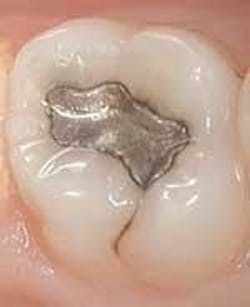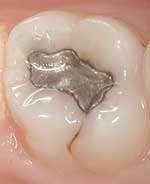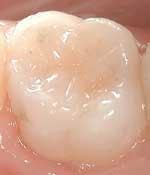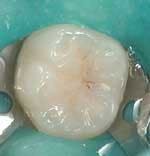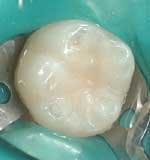Posterior composite restorations
Kevin Winters, DDS
It wasn't that long ago when one of the most controversial dental topics was the use of composite materials on posterior teeth. After all, how could there possibly be a material that could work as well as amalgam or a porcelain-fused-to-metal crown? It was widely accepted that acid etchant could not be placed on dentin without certain pulpal death. Bonding agents were slightly stronger than a coating of butter.
Contrast that time with the way things are now. You have multiple composite systems with wear rates comparable to enamel; direct composites that are strong and lab-processed composites that can replace metal in some instances. Like most other technologies, composites and composite bonding agents continue to get better.
Bonding agents and composites are predictable in use and should be in every doctor's armamentarium. You no longer have to worry about pulps dying from etching. With proper technique — I repeat, proper technique — sensitivity is of little concern. So, now, with these materials being strong, predictable, and long-lasting, let's see how we can make them profitable for us and beneficial for our patients. The fee we charge must be commensurate with the time it takes to do this procedure as well as the perceived value of it. Patients automatically think a composite will cost more than an amalgam, as it should. If you charge a fee that is close to your amalgam fee, you will lose money.
One advantage amalgams have as a restorative option is that they can be done quickly. So, I use a rule of at least 2-to-1 for a composite fee. This is a minimum. Composites take longer than amalgams, but once you become comfortable with the procedure and come up with a definite sequence, your speed can increase as well.
Many doctors find it easy to gain patient acceptance for posterior composites. Patients rarely request black, ugly, mercury-containing fillings. After years of not offering amalgams, I've found that my patients never request them. Don't put them on the menu — take away the confusion.
With so many amalgams placed in teeth, combined with the number of aging baby boomers in our population, there are hundreds of thousands of amalgams that look like the one in Fig. 1, that could look like the one in Fig. 2 when replaced with composite.
Once patients realize their teeth can actually look like teeth again, they get a feeling that they may be in a special place. To patients, this was a very high-tech procedure they just had done. Their perception is, "My last dentist didn't do this for me. This dentist must really know what he is doing."
If our patients begin to perceive us as different or giving better care than they received in the past, we likely will get a higher acceptance for the complete treatment plan. Now, maybe the elective cosmetic treatments or the replacement of the old posterior crowns will be accepted more easily. Now, maybe patients will tell people about their great experiences at your office. This represents some of the momentum that a simple procedure such as posterior composites can create.
Posterior composites can enter into your practice in another not-so-obvious way. During new patient exams, or especially during recall appointments, the use of a DIAGNOdent by KaVo can lead to a whole new profit center. Decay which can go undetected by X-ray or explorer can be extensive. I've been amazed at what this new technology can find. I've also been terrified thinking back at the decay I have left in my patients' teeth.
Once identified, occlusal groove decay can now be handled easily. Presenting this problem becomes fun. Telling patients that you found cavities in their earliest stages and that they can be fixed almost always without a shot is met with patient enthusiasm. Now, if the office has air abrasion or a hard-tissue laser, it can even be presented as a drill-less procedure.
Let's look at this from a profitability standpoint. Let's say you have a lower quadrant with two molars and two premolars isolated in a rubber dam. Isolation should take no more than two minutes. Now, using a bur or air abrasion, the preparations can take as little as another one to two minutes. Next, using accepted bonding regimens and application of either a microhybrid or a flowable composite, the restoration can be applied, cured, and polished in less than 10 minutes. If each restoration costs $150, a total of $600, you can see how this is probably the most productive procedure you can do. No lab fee, no anesthesia time, no patient discomfort, all done in 10 to 15 minutes — that's a great return for your time. (See Figures 3, 4, and 5.)
Indirect posterior composites is another area in which practitioners can introduce a procedure that is beneficial for patients as well as profitable. Instead of pushing the limits of what amalgam can do, why not do dentistry the way we were taught — using the guidelines for tooth preparation established many years ago? These guidelines include the preparation extending beyond more than two-thirds of the intercuspal width requiring an onlay. Many of the classic restorative guidelines are actually ideal for adhesive composite dentistry.
Placing a bonded indirect composite on larger two- and three-surface lesions instead of an amalgam will invariably save many teeth from the ravages of amalgam preparation requirements as well as expansion and contraction of the material. This more conservative restorative option will save most of these teeth from needing to be crowned later as the amalgam-restored teeth will need. The benefit will be an increase in production. The fee for an indirect composite should be equal to your normal crown fee. Some doctors have realized that this restoration requires more skill and should cost more.
Many doctors run into problems when they are reluctant to present the ideal treatment. Then, patients suffer from inferior dentistry, and the dentist suffers from the difference in the production.
This reluctance to present more ideal treatment usually revolves around the doctor's "insurance mindset." If there is a question about whether an insurance company will pay, many dentists stay in their comfort zones and go with something that will always be covered — an amalgam. This is unfortunate for patients because their teeth are compromised forever, and dentists lose income.
There is no reason why dentists should not offer posterior composites. The science, materials, and in vivo time studies have proven that the procedure works. Too many times, dentists do not educate themselves on how to do posterior composites without problems. Many doctors try to use amalgam principles for preparation as well as amalgam techniques for placement. This results in sensitivity. Eventually, doctors are then convinced either posterior composites in general do not work or the composite is no good, the bonding agent is no good, etc.
You can't place a posterior composite without paying attention to exact details. Advancing your knowledge in this area is a must. Live, hands-on, interactive courses given by masters such as Dr. Ron Jackson at the Las Vegas Institute provide clinicians with the science, technique, proper materials, and artistry it takes to provide predictable, high-quality posterior composite restorations. You will learn the importance of rubber dam placement, reasons that sensitivity results and how to avoid them, and the cutting edge of new materials as well as old standbys. Seek out high-quality education. Your patients will thank you.
Don't be lazy. You didn't learn how to do these procedures in dental school. Get out to lectures, over-the-shoulder programs, live patient programs, or at least immerse yourself in journals to learn the techniques. Not only will your patients benefit, but so will your bottom line.
